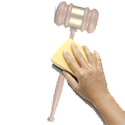The information below may be hepful to you but is not a substitute for legal advice.
A.R.S. means Arizona Revised Statutes and RPEA means Rules of Procedure for Eviction Actions.
A.R.S. means Arizona Revised Statutes and RPEA means Rules of Procedure for Eviction Actions.
Content provided can also be found at AZCourts.gov/eviction.

1. JUDGMENT
- Once a landlord has been awarded a judgment, the a tenant can stay in the rental unit by:
- Working out an agreement with the landlord, or
- Filing an appeal and paying a supersedeas bond.
- Any agreements that are made after an eviction judgment should be in writing and signed by the landlord and tenant.
- Keep a copy of any signed agreements.
- Interest is added to any amount owed from the time of the judgment until paid in full.
- Once a judgment is paid off, the landlord (judgment creditor) must file a satisfaction with the court. A satisfaction lets anybody who looks at the court records know that the landlord has been paid in full.
- The landlord cannot take possession of the property the moment a judgment is entered. They have to wait and serve a writ of restitution.

2. WRIT OF RESTITUTION
- After an eviction, if the tenant does not leave on their own, the landlord can get a writ of restitution order from the court.
- For eviction judgments of immediate and irreparable breach, the landlord can get a writ of restitution the next court day.
- In most cases, the landlord has to go back to court after five days to get a writ of restitution. A.R.S. § 12-1178.
- Writs of restitution must be served to a tenant by a constable or sheriff.
- The landlord may not change the locks or enter the rental unit until:
- The writ of restitution has been issued by the court, and
- served by the constable or sheriff.
- The tenant can call the police if the landlord changes the locks or enters the rental unit too early.
- Once the writ of restitution has been lawfully executed, the tenant may not remain at or return to the rental unit without the express permission of the landlord.
- If the tenant stays or returns to the rental unit without permission, the tenant can be charged with criminal trespass.

3. MOTION TO SET ASIDE JUDGMENT
- There are 10 specific reasons to file a motion to set aside the judgment (RPEA 15):
- The eviction was not filed or heard at the right courthouse (improper jurisdiction);
- The tenant paid all money owed under the lease agreement before a judgment was entered or made a partial payment under ARLTA that was accepted by the landlord;
- The tenant did not receive proper notice or were not properly served;
- Mistake, inadvertence, surprise, or excusable neglect;
- Newly discovered material facts exist that could establish a defense to an allegation;
- The tenant is protected under bankruptcy laws;
- The tenant is requesting relief under the Servicemembers Civil Relief Act;
- The landlord and tenant have both agreed to set aside judgment;
- The court judgment does not follow the law; or
- The landlord misrepresented themselves, committed fraud, or another type of misconduct.
- For certain reasons, a motion to set aside the judgment must be filed with the trial court not more than 60 days after the judgment. For other grounds, the motion must be filed within a reasonable time.
- Filing a motion to set aside the judgment does not prevent the execution of a writ of restitution or allow the tenant to stay in the rental unit.

4. APPEAL
- If you wish to appeal, you have 5 days to file a notice of appeal after the judge has signed the judgment. Filing the notice of appeal will not allow the tenant to remain in the rental unit.
- There is a fee to file an appeal, but if you cannot afford the fee, you may request a deferral or waiver.
- Fee waiver or deferral waivers can be found here: http://azcourthelp.org/topics/fwd

5. BONDS
- To file an appeal, a $250.00 cost bond has to be paid, but you can apply to have it waived or deferred.
- To temporarily stop a writ of restitution, a supersedeas bond can be filed with the trial court. This allows the tenant to remain in the rental unit while the appeal is heard. This bond cannot be waived or deferred. In the case of an immediate termination, the supersedeas bond must be paid to the trial court before the writ of restitution is issued.
- The amount of the supersedeas bond varies depending on the:
- amount of rent due (from the date of judgment until the next periodic rental date),
- costs, and
- attorney fees.
- Additionally, the tenant must pay monthly rent to the court on or before the monthly due date during the appeal to remain in the property while the appeal is being heard.

6. PERSONAL PROPERTY
- This does not apply to mobile homes.
- The landlord must hold the tenant’s personal property for 14 days after the constable or sheriff serves the writ of restitution, but the tenant must pay for the cost of removal and storage (NOT the judgment amount) to recover personal property. Certain personal items are excluded from this requirement. For instance, landlords may take animals immediately to a shelter. See A.R.S. § 33-1368(E) and A.R.S. § 33-1370 for additional information related to personal property left in a rental unit after an eviction.

7. SECURITY DEPOSIT
- This does not apply to mobile homes.
- The landlord can apply the tenant’s refundable security deposit to unpaid rent and other lawful charges after an eviction. The landlord must send an itemized list of the charges to the tenant’s last known address. If the tenant does not dispute (preferably in writing) the charges within 60 days after the list is mailed, then the charges are considered final. See A.R.S. § 33-1321(D) for more information on obtaining a refund of the security deposit from the landlord.
